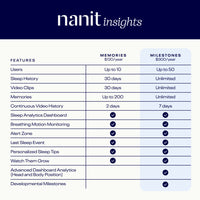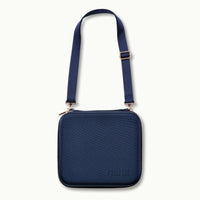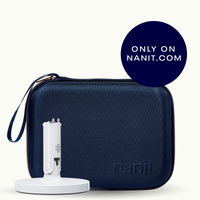Babies are nose breathers for the first 3-4 months of their life and as a result can sound very stuffy and snotty when congested. When babies are sneezing, they are trying to clear some of that nasal congestion. Sneezing in newborns is not due to allergies or a cold but due to the mucus in the nasal passages that the baby is trying to clear.
Understanding infant congestion
Like adults, infants can become congested for many reasons. The key difference is that adults can blow their own noses, while babies rely on sneezing (which may not always be effective) and parents to lubricate the mucus and either pick out large pieces of snot with a nose picker or gently aspirate it with a nasal aspirator.
The most common reason why your newborn is stuffed up is:
Because of the dry air they are inhaling and humidifying through their nasal passages as obligate nose breathers. When there is not enough moisture in the air, the nasal tract overcompensates and produces more mucus, which can cause more congestion.
Newborns have small nasal passages making it easier for the mucus that builds up to clog their nasal passages causing congestion.
If at any point it appears that your baby is having difficulty getting air into their lungs (as opposed to nasally and noisy breathing), you should contact/visit your pediatrician.
Home remedies for congestion
If you’re stumped on how to soothe your baby’s congestion, there are many safe at-home solutions to help your little one breathe more comfortably and quietly.
(Safety note: These recommendations are not meant to replace the advice and care of a medical professional. Consult your pediatrician about how best to treat your baby.)
It may be tempting to have your baby sleep on an incline when congested but this is never recommended due to safe sleep guidelines. To decrease the risks of SIDS, infants should always be placed to sleep on their back, on a flat and firm mattress.
Suction devices
Physically removing excess mucus with a nasal aspirator from each nostril can sometimes be helpful, but more valuable is saline spray/drops that help lubricate the mucus making it easier for babies to clear it.
Steam inhalation
Moist, warm air helps to loosen mucus, open the nasal passage, and reduce congestion. There are many at-home solutions, such as:
- Humidifiers
- A steamy bathroom
- A warm bath
Nasal solutions
Saline rinses can thin out mucus, making it easier to clear the mucus. When using a bulb syringe or nasal aspirator, it helps to first use a saline spray to loosen and thin the mucus. You can purchase over-the-counter saline drops for babies.
When to seek medical advice
While mild congestion is not cause for alarm, it is important to be aware of when your baby’s respiratory symptoms are cause for concern. When in doubt about how to manage your baby’s congestion, it is always best to consult your pediatrician.
Watch for warning signs and symptoms that your baby is working hard to breathe and warrants a visit to your pediatrician:
- Labored breathing (it seems to take a lot of effort for your baby to inhale)
- a consistently faster respiratory rate (>60 breaths per minute)
- Pulling noted at the top of the breastbone or between the ribs as they breathe (retractions)- indicating increased work required to get a full breath
- Flared nostrils with each inhalation
Enlist a helping hand with Nanit
Whether your baby is a little stuffed up or they’re breathing easy, it’s always nice to have an expert set of eyes and ears tuning in. That’s where Nanit comes in.
Gain valuable insight into your baby’s breathing motion and sleep patterns with our camera and specialized Breathing Wear. Our sensor-free swaddles, sleeping bags, and wearable Breathing Band work with the Pro Camera to track your baby’s breathing motion and breaths per minute, providing a comprehensive overview of your baby's wellness, including instances of rapid breathing.
Thanks to our integrated system, Breathing Wear seamlessly connects with the Nanit Pro Camera and sends your data right to your phone. If anything is out of the ordinary, you’ll receive real-time alerts.
Key takeaways
- Congestion in babies is fairly common. A baby’s smaller nasal passages and for the first 3-4 months of life they breathe exclusively through their nose making it prime for a buildup of mucus/congestion
- There are ways to help at home. Nasal saline drops/spray, nasal aspirators, a steamy bathroom, and humidifiers help to loosen and clear your baby’s nasal congestion.
- Look out for warning signs of a more serious case. If your baby shows signs that they’re working harder to breathe and their respiratory effort is labored, consult your doctor immediately.
Have more questions about what might be going on with your lackluster little one? Check out, “What are the signs that my baby is sick?” or watch our expert tips for helping a congested baby sleep:
Sources:
National Institute of Child Health and Human Development. Infant Sleep Position and SIDS. https://www.nichd.nih.gov/sites/default/files/publications/pubs/documents/SIDS_QA-508-rev.pdf.
Healthy Children. My baby has a stuffy nose. How can I help them sleep safely? https://www.healthychildren.org/English/tips-tools/ask-the-pediatrician/Pages/my-baby-has-a-stuffy-nose-how-can-i-help-them-sleep-safely.aspx
Children’s Health. Treating nasal congestion in babies and toddlers. https://www.childrens.com/health-wellness/nasal-congestion-in-babies-and-toddlers
University Hospitals. What to Do For Your Baby's Stuffy Nose. https://www.uhhospitals.org/blog/articles/2019/01/what-to-do-for-a-babys-stuffy-nose









































